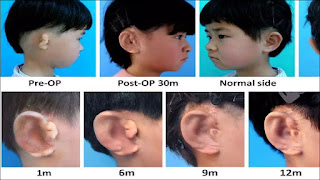EAR TRANSPLANTED AFTER GROWN BY OWN CELLS IN LAB USING 3D PRINTED BIOGRADABLE MOULD
PROF .DRRAM,HIV /AIDS,HEPATITIS ,SEX DISEASES & WEAKNESS expert,New Delhi,India, profdrram@gmail.com,+917838059592,+919832025033,ON WHATSAPP
If we transplant any organ or tissue in plastic or regenrative medicine ,most important thing is iso indentical compatablity immunologicaly between recepient and donot otherwise graft is either rejected or graft versus host reactions occur which may reject graft beside producing toxic effect on many other organs too.But this can be easily avoided if we use our own tissue either from our body or cultured or grown in lab from our embryogenic cell.
Thus in a new study,Scientists have made a breakthrough in regenerative medicine after they successfully grew a perfectly compatible ear in a lab and grafted it onto a patient.Five children have received new ears through the process – a world's first – which uses their own cells combined with a 3D-printed biodegradable mould.The children, aged between six and nine years, who underwent the experimental surgery were all born with a defect in one ear known as microtia, a condition in which the external ear is small and underdeveloped.
Two-and-a-half years ago, the first child to undergo the procedure showed no signs. The body had rejected or accidentally absorbed the new cells, the Chinese team who developed the procedure wrote when they published their findings in the journal EbioMedicine.
 The scientists created reversed 3D-printed replicas of the children’s normal ears and used the replicas to make biodegradable moulds full of tiny holes.The next step involved the collection of the cartilage cells called chondrocytes from the children’s deformed ears which were used to grow ear-shaped cartilage with the moulds in a lab.After three months, the ears grown in the lab were grafted on the children as the cartilage cells begin to grow in the shape of the mould, and the mould itself begins to break down.
The scientists created reversed 3D-printed replicas of the children’s normal ears and used the replicas to make biodegradable moulds full of tiny holes.The next step involved the collection of the cartilage cells called chondrocytes from the children’s deformed ears which were used to grow ear-shaped cartilage with the moulds in a lab.After three months, the ears grown in the lab were grafted on the children as the cartilage cells begin to grow in the shape of the mould, and the mould itself begins to break down.
“It’s a very exciting approach,” Tessa Hadlock, a reconstructive plastic surgeon at the Massachusetts Eye and Ear Infirmary in Boston, told New Scientist, which first reported on the research.“They’ve shown that it is possible to get close to restoring the ear structure.”The recipients of the new ears will now be monitored by the scientists for the next five years to evaluate the success of the procedure – whether the ears remain intact after the moulded scaffold has completely broken down – and working to refine the procedure in the hope of producing increasingly natural-looking ears.
The surgery was reportedly inspired by the so-called 'earmouse', a lab mouse which appeared to have a human ear growing on its back.
- Kidney stones universally present hazard in north india,dillution by water prevent it
- Steroid and placebo effect equally for mild persisting asthma with low sputum eosinophils
- Government wants to fix public healthcare staff shortages with ayush docs: will it work?
- Plea in hc for payment of salaries of edmc, north mcd teachers and doctors
- 7 indian pharma companies named in us lawsuit over inflating generic drug prices
- Woman in up dies after explosion in her mouth during treatment,what is diagnosis?
- Woman in up dies after explosion in her mouth during treatment,what is diagnosis?
- Woman in up dies after explosion in her mouth during treatment,what is diagnosis?
- Air pollution ! mothers organising rally in london,anaesthetist choosing gas,will india follow?
- Cardiac arrest is always not sudden as understood -a study

 Comments (
Comments ( Category (
Category ( Views (
Views (